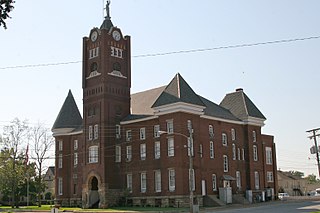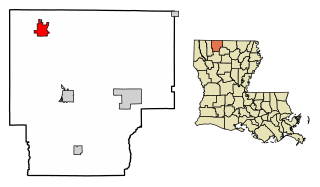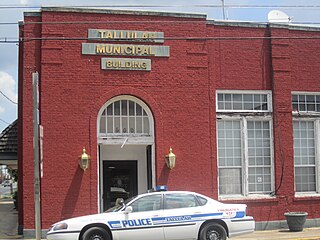
Madison Parish is a parish located on the northeastern border of the U.S. state of Louisiana, in the delta lowlands along the Mississippi River. As of the 2020 census, the population was 10,017. Its parish seat is Tallulah. The parish was formed in 1839.

Jackson Parish is a parish in the northern part of the U.S. state of Louisiana. As of the 2020 census, the population was 15,031. The parish seat is Jonesboro. The parish was formed in 1845 from parts of Claiborne, Ouachita, and Union Parishes. In the twentieth century, this part of the state had several small industrial mill towns, such as Jonesboro.

Newport is a city in and the county seat of Jackson County, Arkansas, United States located on the White River, 84 miles (135 km) northeast of Little Rock. The population was 7,879 at the 2010 census.

DeQuincy is the northernmost city in Calcasieu Parish, Louisiana, United States. The population was 3,235 at the 2010 census. DeQuincy is part of the Lake Charles metropolitan statistical area.

Haynesville is a town in northern Claiborne Parish, Louisiana, United States, located just south of the Arkansas border. The population was 2,039 in 2020.

Homer is a town in and the parish seat of Claiborne Parish in northern Louisiana, United States. Named for the Greek poet Homer, the town was laid out around the Courthouse Square in 1850 by Frank Vaughn. The present-day brick courthouse, built in the Greek Revival style of architecture, is one of only four pre-Civil War courthouses in Louisiana still in use. The building, completed in 1860, was accepted by the Claiborne Parish Police Jury on July 20, 1861, at a cost of $12,304.36, and is on the National Register of Historic Places. The other courthouses are in St. Francisville, St. Martinville and Thibodaux.

Jackson is a town in East Feliciana Parish, Louisiana, United States. The population was 3,842 at the 2010 U.S. census, down from 4,130 in 2000; the 2020 population estimates program determined Jackson had a population of 3,707. It is part of the Baton Rouge metropolitan statistical area.

Tallulah is a city in, and the parish seat of, Madison Parish in northeastern Louisiana, United States. As of the 2020 census, the population was 6,286, down from 7,335 in 2010.

Morganza is an incorporated village near the Mississippi River in Pointe Coupee Parish, Louisiana, United States. The population was 610 at the 2010 census, down from 659 in 2000. As of 2020 the population was 525. It is part of the Baton Rouge metropolitan statistical area. The village's zip code is 70759. The Morganza Spillway, a flood control structure between the Mississippi River and the Atchafalaya Basin, is located nearby.

Pineville is a city in Rapides Parish, Louisiana, United States. It is located across the Red River from the larger Alexandria, and is part of the Alexandria Metropolitan Statistical Area. The population was 14,555 at the 2010 census. It had been 13,829 in 2000; population hence grew by 5 percent over the preceding decade.

Coushatta is a town in, and the parish seat of, rural Red River Parish in north Louisiana, United States. It is situated on the east bank of the Red River. The community is approximately 45 miles south of Shreveport on U.S. Highway 71. The population, 2,299 at the 2000 census, is nearly two-thirds African American, most with long family histories in the area. The 2010 census, however, reported 1,964 residents, a decline of 335 persons, or nearly 15 percent during the course of the preceding decade. In 2020, its population was 1,752. The city is named after the Coushatta, a Native American nation indigenous to the region.

Hammond is the largest city in Tangipahoa Parish, Louisiana, United States, located 45 miles (72 km) east of Baton Rouge and 45 miles (72 km) northwest of New Orleans. Its population was 20,019 in the 2010 U.S. census, and 21,359 at the 2020 population estimates program.

Waterproof is a village in Tensas Parish in northeastern Louisiana, United States with a population of 688 as of the 2010 census. The village in 2010 was 91.7 percent African American. Some 24 percent of Waterproof residents in 2010 were aged sixty or above.

Bogalusa is a city in Washington Parish, Louisiana, United States. The population was 12,232 at the 2010 census. In the 2020 census the city reported a population of 10,659. It is the principal city of the Bogalusa Micropolitan Statistical Area, which includes all of Washington Parish and is also part of the larger New Orleans–Metairie–Hammond combined statistical area.

Natchez is the only city in and the county seat of Adams County, Mississippi, United States. It has a total population of 14,520. Located on the Mississippi River across from Vidalia in Concordia Parish, Louisiana, Natchez was a prominent city in the antebellum years, a center of cotton planters and Mississippi River trade.
The Deacons for Defense and Justice was an armed African-American self-defense group founded in November 1964, during the civil rights era in the United States, in the mill town of Jonesboro, Louisiana. On February 21, 1965—the day of Malcolm X's assassination—the first affiliated chapter was founded in Bogalusa, Louisiana, followed by a total of 20 other chapters in this state, Mississippi, Arkansas, and Alabama. It was intended to protect civil rights activists and their families, threatened both by white vigilantes and discriminatory treatment by police under Jim Crow laws. The Bogalusa chapter gained national attention during the summer of 1965 in its violent struggles with the Ku Klux Klan.
Deacons for Defense is a 2003 American television drama film directed by Bill Duke. The television film stars Forest Whitaker, Christopher Britton, Ossie Davis, Jonathan Silverman, Adam Weiner, and Marcus Johnson. Based on a story by Michael D'Antonio, the teleplay was written by Richard Wesley and Frank Military.
Frederick Douglass Kirkpatrick (1933–1986) was an African-American musician, civil rights activist, and minister from Haynesville, Louisiana. In late 1964 he was a co-founder of the Deacons for Defense and Justice, an armed black self-defense group, in the small industrial mill town of Jonesboro, Louisiana, to protect the black community against white violence. Together with Earnest "Chilly Willy" Thomas, Kirkpatrick also founded Deacons chapters in other cities of Louisiana, and in Mississippi and Alabama.

The Robert Hicks House, in Bogalusa, Louisiana, was the home from 1965 to 1969 of civil rights leader Bob Hicks (1929–2010) and the site of civil rights meetings in the city. The house, built in the early 1950s, is a one-story 1,590 sq ft (148 m2) building with similarities to 1950s ranch houses and 1930s bungalows. It has weatherboard siding and is built on concrete piers.
Robert Hicks was a prominent leader in Bogalusa, Louisiana during the Civil Rights Movement, whose activism helped put an end to segregation and discriminatory practices in education, housing, employment, public accommodations and healthcare. Best known for his leading role in founding the Bogalusa chapter of The Deacons for Defense and Justice, an armed African-American self-defense group, Hicks led daily protests on the streets of Jim Crow-era Bogalusa. He served as president and later Vice President of the Bogalusa Civic and Voters League, and the plaintiff in a series of civil rights lawsuits which achieved groundbreaking legal victories nationwide.

























